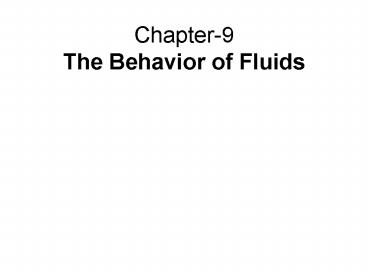Chapter-9 The Behavior of Fluids PowerPoint PPT Presentation
Title: Chapter-9 The Behavior of Fluids
1
Chapter-9 The Behavior of Fluids
2
Outline
- 1 Pressure, Hydraulics, and Pascals Principle
- 2 Atmospheric Pressure and the Behavior of Gases
- 3 Archimedes Principle
- 4 Fluids in Motion
- 5 Bernoullis Principle
- Everyday Phenomenon
- Throwing a Curve Ball
3
Variables That Are Commonly Used to Quantify a
Gas
Variable Variable
Name Symbol
Pressure P
Volume V
Temperature T
Amount of gas, of moles n
4
Boyles Law
How does the volume of a gas change with
pressure? In order to observe this, we will visit
the following Java site.
5
Boyles Law
How does the volume of a gas change with
pressure? In order to observe this, we will visit
the following Java site. Boyles law can be
expressed using symbols as follows
6
9.3archimedes Principle Archimedes of Syracuse
(287BC-212BC)
Much of Archimedes fame comes from his
relationship with Hiero, the king of Syracuse,
and Gelon, Hiero's son. At one time, the king
ordered a gold crown and gave the goldsmith the
exact amount of gold to make it. When Hiero
received it, the crown had the correct weight but
the monarch suspected that some silver had been
used instead of the gold. Since he could not
prove it, he brought the problem to Archimedes.
7
Eureka
One day while considering the question, "the wise
one" entered his bathtub and recognized that the
amount of water that overflowed the tub was
proportional the amount of his body that was
submerged. This observation is now known as
Archimedes' Principle and gave him the means to
solve the problem. He was so excited that he ran
naked through the streets of Syracuse shouting
"Eureka! eureka!" (I have found it!). The
fraudulent goldsmith was brought to justice.
8
Buoyant Force
9
Archimedes Principle
The buoyant force acting on an object fully or
partially submerged in a fluid is equal to the
weight of the fluid displaced by the object.
10
CP4
11
Viscosity
A measure of the frictional forces between the
layers of a fluid producing resistance to flow.
Highly viscous fluids flow slowly.
12
The velocity increases rapidly from the wall
inward for a low-viscosity fluid but more
gradually for a high-viscosity fluid
13
Laminar and Turbulent flow
14
9.5 Bernoullis Principle
For steady flow, the speed, pressure, and
elevation of an incompressible and nonviscous
fluid are related by an equation discovered by
Daniel Bernoulli (17001782). At the same
elevation, the sum of the pressure plus the
kinetic energy per unit volume of a flowing fluid
must remain constant.
15
The pressure of a moving fluid is greater when
the fluid velocity is smaller.
16
Demonstrating Bernoullis Principle
17
Lift on an airplane wing
18
Airplane
19
A batter is fooled by a curveball
20
Spinning Baseball
21
Curveball Pitch

